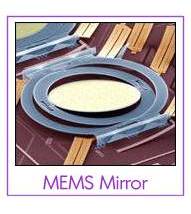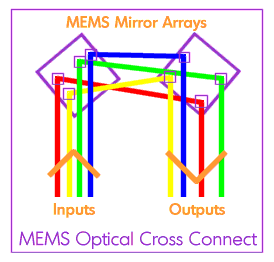Devices that can switch optical signals between different optical fibers, without the need for conversion to electrical signals
August 1, 2001

Before reading this you may find the following tutorials useful:
Optical Networks, Wavelength Division Multiplexing (WDM)
Huge amounts of information traveling around an optical network need to be switched through various points known as “nodes.” Information arriving at a node will be forwarded on towards its final destination via the best possible path, which may be determined by such factors as distance, cost, and the reliability of specific routes. The conventional way to switch the information is to detect the light from the input optical fibers, convert it to an electrical signal, and then convert that back to a laser light signal, which is then sent down the fiber you want the information to go back out on.
It all sounds unnecessarily complicated, don't you think? It's as if to give money to a friend, you would have to convert it into Euros, then back into your own currency before your friend can use it. Now, even though your information is safer in electrical form than your money may be in Euros, it still seems a strange way to work. What if we could just move the light itself around, without all this ridiculous conversion to electric signals? Well, my friend, what you need is an optical crossconnect (OXC).
The advantages of being able to avoid the conversion stage are significant. “Optical switching” should be cheaper, as there is no need for lots of expensive high-speed electronics. Removing this complexity should also make for physically smaller switches. Additionally, optical switches are relatively future-proof. An electrically based switch will have electronics designed to detect the incoming light signal. If you increase the speed at which the light signals operate (increasing the “bit-rate”) then the electronics will need to be upgraded to handle the faster speeds. If you are just rerouting light, however, it doesn't matter how fast the data is coming — so you can accommodate any future upgrades of bit-rate without needing to upgrade the switch (this is called “bit-rate transparency”). Optical crossconnects are just now coming onto the market with these benefits and more.
Optical crossconnects are very much designed with simplicity in mind. You've got some light in one fiber that you want to move to a different fiber, so just redirect the light somehow and that's all you need — it's child's play. Unfortunately, the technologies used seem to come out of science fiction rather than a child's bedtime story. There is a wide range of wild and wacky ways to switch light between optical fibers. Semiconductor amplifiers, liquid crystals, holographic crystals, and tiny moveable mirrors are just a few. Truly buttock-clenching switching developments are anticipated in the future. One of the most common techniques being developed is that of the tiny moveable mirrors known as micro-electro-mechanical systems (MEMS).
 MEMS consist of mirrors no larger in diameter than a human hair. They can be arranged on special pivots so that they can be moved in three dimensions, and several hundred such mirrors can be placed together on mirror arrays no larger than a few centimeters square. Light from an input fiber is aimed at a mirror, which is directed to move the light to another mirror on a facing array. This mirror then reflects the light down towards the desired output optical fiber. It perhaps sounds a little bizarre, but it does seem to work. MEMS mirror arrays are even used successfully in some of the modern digital projectors used for computer-based presentations.
MEMS consist of mirrors no larger in diameter than a human hair. They can be arranged on special pivots so that they can be moved in three dimensions, and several hundred such mirrors can be placed together on mirror arrays no larger than a few centimeters square. Light from an input fiber is aimed at a mirror, which is directed to move the light to another mirror on a facing array. This mirror then reflects the light down towards the desired output optical fiber. It perhaps sounds a little bizarre, but it does seem to work. MEMS mirror arrays are even used successfully in some of the modern digital projectors used for computer-based presentations.
Key Points
Crossconnects forward signals to their destination by specific routes
Traditional crossconnects convert light to electricity then back to light
Optical crossconnect advantages include cost, size, and bit-rate transparency
Redirecting light from one optical fiber to another, without electrical conversion
Most advanced optical switching technology is MEMS, tiny moveable mirrors
Further Reading
Fiber Bragg Gratings (FBGs), Arrayed Waveguide Gratings (AWGs), Semiconductor Optical Amplifiers (SOAs)
You May Also Like









